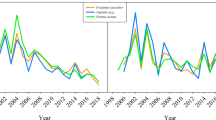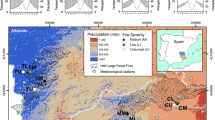Abstract
Holm oak (Quercus ilex L.) and Aleppo pine (Pinus halepensis Mill) are representative of two different functional types of trees extensively found in the Mediterranean: evergreen sclerophyllous and drought-adapted conifers. The former is considered a partially drought-tolerant species, whereas the latter is a typically drought-avoiding, water-saving species. We postulated that contrasting strategies in response to water deficits in Q. ilex and P. halepensis would lead to a differential sensitivity to changes in water availability. To test this hypothesis, we compared the response of both species in growth rate (measured as radial increments) and intrinsic water use efficiency [WUEi, as inferred from carbon isotope discrimination (Δ13C) in wood samples] among sites from different provenance regions in NE Spain. We found significant differences in Δ13C and growth among provenance regions, partly explained by contrasting water availability. Wood Δ13C was positively related with precipitation and the ratio between precipitation and potential evapotranspiration (P / E). However, these relationships were stronger in P. halepensis (for P / E, r 2=0.67, P <0.001) than in Q. ilex (r 2=0.42, P <0.01). In addition, radial growth was positively related with precipitation and Δ13C in P. halepensis (r 2=0.32 and r 2=0.35, respectively, P <0.01), but not in Q. ilex. We concluded that P. halepensis was more sensitive than Q. ilex to water availability, showing faster increase in WUEi in response to water stress. We also found that the effect of north/south aspect on Δ13C and growth was site-specific, and unrelated to climatic variables.





Similar content being viewed by others
References
Anderson JE, Williams J, Kriedemann PE, Austin MP, Farquhar GD (1996) Correlations between carbon isotope discrimination and climate of native habitats for diverse eucalypt taxa growing in a common garden. Aust J Plant Physiol 23:311–320
Anderson WT, Bernasconi SM, McKenzie JA, Saurer M (1998) Oxygen and carbon isotopic record of climatic variability in tree ring cellulose (Picea abies): an example from central Switzerland (1913–1995). J Geophys Res 103:31,625–31,636
Borghetti M, Cinnirella S, Magnani F, Saracino A (1998) Impact of long-term drought on xylem embolism and growth in Pinus halepensis Mill. Trees 12:187–195
Brooks JR, Flanagan LB, Ehleringer JR (1998) Responses of boreal conifers to climate fluctuations: indications from tree-ring widths and carbon isotope analyses. Can J For Res 28:524–533
Damesin C, Rambal S, Joffre R (1997) Between-tree variations in leaf δ13C of Quercus pubescens and Quercus ilex among Mediterranean habitats with different water availability. Oecologia 111:26–35
Damesin C, Rambal S, Joffre R (1998) Co-occurrence of trees with different leaf habit: a functional approach on Mediterranean oaks. Acta Oecol 19:195–204
Dupouey JL, Leavitt S, Choisnel E, Jourdain S (1993) Modelling carbon isotope fractionation in tree rings based on effective evapotranspiration and soil water status. Plant Cell Environ 16:939–947
Fallas AL (1970) The seasonal variation of monosaccharides, shikimic acid and quinic acid in one-year-old shoots from 15-year-old grafted clones of Picea abies (L.). Karstenia 103:141–168
Farquhar GD, O’Leary MH, Berry JA (1982) On the relationship between carbon isotope discrimination and the intercellular carbon dioxide concentration in leaves. Aust J Plant Physiol 9:121–137
Fleck I, Grau D, Sanjosé M, Vidal D (1996) Carbon isotope discrimination in Quercus ilex resprouts after fire and tree-fell. Oecologia 105:286–292
Francey RJ, Allison CE, Etheridge DM, Trudinger CM, Enting IG, Leuenberger M, Langenfields RL, Michel E, Steele LP (1999) A 1000-year high precision record of δ13C in atmospheric CO2. Tellus 51B:170–193
Gandullo JM (1994) Climatología y ciencia del suelo. Fundación Conde del Valle de Salazar, Madrid
Gené C, Espelta JM, Gràcia M, Retana J (1993) Identificación de los anillos anuales de crecimiento de la encina (Quercus ilex L.). Orsis 8:127–139
Jones HG (1992) Plants and microclimate. Cambridge University Press, Cambridge
Köppen W, Geiger R (eds) (1936) Handbuch der klimatologie. Gebrüder Bornträger, Berlin
Korol RL, Kirschbaum MUF, Farquhar GD, Jeffreys M (1999) Effects of water status and soil fertility on the C-isotope signature in Pinus radiata. Tree Physiol 19:551–562
Lebourgeois F (2000) Climatic signals in earlywood, latewood and total ring width of Corsican pine from western France. Ann For Sci 57:155–164
Leiva MJ, Fernández-Alés R (1998) Variability in seedling water status during drought within a Quercus ilex subsp. ballota population, and its relation to seedling morphology. For Ecol Manage 111:147–156
Liphschitz N, Lev-Yadun S (1986) Cambial activity of evergreen and seasonal dimorphics around the Mediterranean. IAWA Bull 7:145–153
Little RC, Freund RJ, Spector PC (1991) SAS system for linear models, 3rd edn. SAS, Cary, N.C., USA
Livingston NJ, Spittlehouse DL, Ehleringer JR, Hall AE, Farquhar GD (1993) Carbon isotope fractionation in tree rings in relation to the growing season water balance. In: Ehleringer JR, Hall AE, Farquhar GD (eds) Stable isotopes and plant carbon-water relations. Academic Press, San Diego, pp 141–153
Martín S, Díaz-Fernández P, DeMiguel J (1998) Regiones de procedencia de especies forestales españolas. O.A. Parques Nacionales, Madrid
Nicault A, Rathgeber C, Tessier L, Thomas A (2001) Observations on the development of rings of Aleppo pine (Pinus halepensis Mill.): confrontation between radial growth, density and climatic factors. Ann For Sci 58:769–784
Saurer M, Siegenthaler U (1989) 13C/12C isotope ratios in trees are sensitive to relative humidity. Dendrochronologia 7:9–13
Saurer M, Siegenthaler U, Schweingruber F (1995) The climate-carbon isotope relationship in tree rings and the significance of site conditions. Tellus 47B:320–330
Schulze ED, Williams RJ, Farquhar GD, Schulze W, Langridge J, Miller JM, Walker BH (1998) Carbon and nitrogen isotope discrimination and nitrogen nutrition of trees along a rainfall gradient in northern Australia. Aust J Plant Physiol 25:413–425
Serre F (1976) The relation between growth and climate in Aleppo pine (Pinus halepensis). I. Methods. Cambial activity and climate. Oecol Plant 11:143–171
Stuiver M, Braziunas TF (1987) Tree cellulose 13C/12C isotope ratios and climate change. Nature 328:58–60
Thornthwaite CW (1948) An approach towards a rational classification of climate. Geogr Rev 38:55–94
Tognetti R, Michelozzi M, Giovannelli A (1997) Geographical variation in water relations, hydraulic architecture and terpene composition of Aleppo pine seedlings from Italian provenances. Tree Physiol 17:241–250
Valentini R, Mugnozza GES, Ehleringer JR (1992) Hydrogen and carbon isotope ratios of selected species of Mediterranean macchia ecosystem. Funct Ecol 6:627–631
Villar-Salvador P, Castro-Díez P, Pérez-Rontomé C, Montserrat-Martí G (1997) Stem xylem features in three Quercus (Fagaceae) species along a climatic gradient in NE Spain. Trees 12:90–96
Warren CR, McGrath JF, Adams MA (2001) Water availability and carbon isotope discrimination in conifers. Oecologia 127:476–486
Williams DG, Ehleringer JR (1996) Carbon isotope discrimination in three semi-arid woodland species along a monsoon gradient. Oecologia 106:455–460
Acknowledgements
This work was partly supported by the CICYT grant BTE2001-3421-C02. P.F. has a PhD. fellowship from Generalitat de Catalunya. We thank Instituto Nacional de Meteorología and Confederación Hidrográfica del Ebro for providing meteorological data, and CU-INSTAAR/NOAA-CMDL for air δ13C values. We also thank the gentle collaboration of the Parc Natural de la Zona Volcànica de la Garrotxa, and the forest services from Aragón and Catalunya.
Author information
Authors and Affiliations
Corresponding author
Rights and permissions
About this article
Cite this article
Ferrio, J.P., Florit, A., Vega, A. et al. Δ13C and tree-ring width reflect different drought responses in Quercus ilex and Pinus halepensis . Oecologia 137, 512–518 (2003). https://doi.org/10.1007/s00442-003-1372-7
Received:
Accepted:
Published:
Issue Date:
DOI: https://doi.org/10.1007/s00442-003-1372-7




